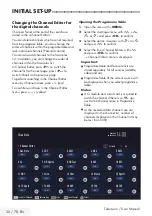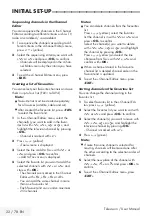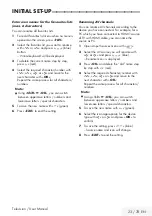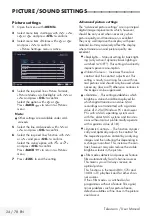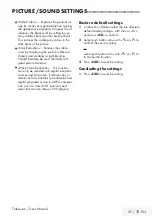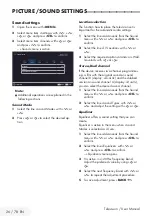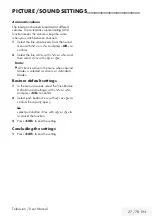
34 / 78 EN
Television / User Manual
USB OPERATION
--------------------------------------------------------------------------------------------
File formats for USB operating
Your television can be operated via the USB
input with the following file formats:
Video data
Special codecs for video compression and
decompression provide more memory space
without compromising the picture quality
excessively.
Your television plays video files in the formats
XVID, H.264/MPEG-4 AVC (L4.1, 4 reference
pictures), MPEG-4, MPEG-2, MPEG-1, MJPEG
and MOV.
The following file name extensions are also
supported: “.avi”, “mkv”, “.mp4”, “.ts”, “.mov”,
“.mpg”, “.dat”, “.vob”,”.divx”. In addition to
video data, these files also contain audio data
compressed and "packaged" by using MP3,
AAC or Dolby Digital.
Format (codec) information is embedded within
the file content and may differ depending on
the file extension. “.avi”, “.mkv” or “.divx”
files containing divx codec within are not
playbacked.
Image data
Your television can display picture data in JPEG,
PNG and BMP formats.
JPEG stands for Joint Picture Experts Group. This
process is intended to compress picture files.
PNG and BMP standards are intended to
compress picture data without loss.
Picture files can be saved in a data storage
medium together with other file types.
Such files can be organized as folders and
subfolders.
Audio data
Your television can play audio data coded with
MP3, AAC standards.
MP3 stands for MPEG-1 Volume Level 3 and is
based on the MPEG-1 standard developed by
MPEG (Motion Picture Expert Group).
AAC indicates the Advanced Audio Coding and
is developed by MPEG. AAC provides higher
audio quality with the same data rate (bit rate).
These formats enable audio files to be saved on
storage devices with a sound quality similar to
that of a CD.
File extensions supported by your device:
“.mp3”, “.mp2”, “.m4a”, “.aac”, “.wav”
MP3 files can be organised into folders and
subfolders similar to the files on a computer.

